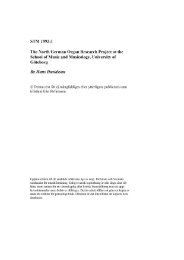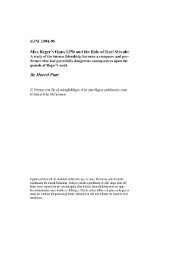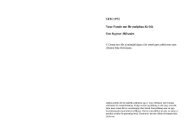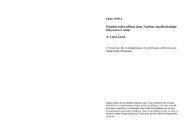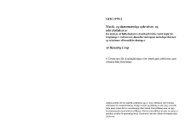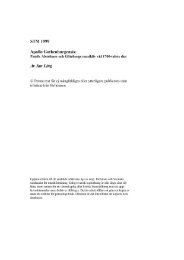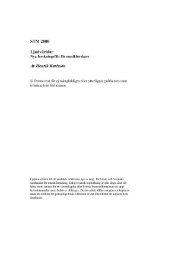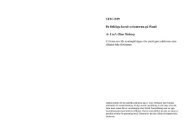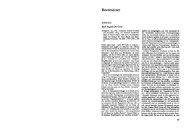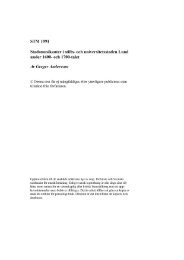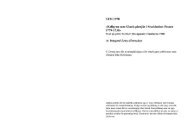Nicolai
Nicolai
Nicolai
You also want an ePaper? Increase the reach of your titles
YUMPU automatically turns print PDFs into web optimized ePapers that Google loves.
(das Zierliche). It seems to me that much of Mozart’s music incorporates both<br />
”das Erhabene” and ”das Anmutige”. The latter quality is also abundantly present<br />
in Der Rosenkavalier.<br />
In Hartmann’s opinion absolute music is not capable of the comical. However,<br />
”Doch selbst von der reinen Musik muss man sagen, dass sie in gewissen Werken<br />
dem Komischen sehr nahe kommt: sie ist des Heiteren und Lustigen fähig, des-<br />
gleichen des Launigen, Kapriziösen, Leichtfüssigen und Sprunghaften, ja des<br />
Ausgelassenen und unbesorgt Leichtsinnigen. Ist es von dort nicht nur ein geringer<br />
Schritt zum Komischen?” (P. 453.) But this should not lead us to think that music<br />
is really comical. These qualities are more nearly associated with the gracious, and<br />
thus we leave the realm of the comical.<br />
Finally, a few words by way of commentary. One salient feature of Hartmann’s<br />
philosophical outlook becomes apparent to anyone who has penetrated his works-<br />
and that is that he is so overwhelmingly positive. There is little trace of scepticism<br />
or pessimism in his practical philosophy (ethics and aesthetics). Hartmann also<br />
recognizes absolute values and a value-hierarchy. One can not help but admire<br />
the boldness of his value-intuitions, but there is undeniably a risk of dogmatism.<br />
Any philosophy of musical evaluation which aspires to universality is bound,<br />
in this day and age, to face insurmountable difficulties. Historians of music are<br />
always evaluating-indeed, it would seem impossible to write a book on music<br />
history and not do so. But they evaluate music within the same tradition. It seems<br />
to us perfectly objective and convincing when a historian compares, say, a can-<br />
tata by Telemann with one by Bach and finds the one by Bach to be greater;<br />
or compares a violin concerto by Spohr with one by Mendelssohn, finding the<br />
latter’s to be greater. All well and good. But enormous difficulties present them-<br />
selves as soon as an attempt is made to evaluate in comparison two truly great<br />
composers who are great in different ways. Take, for example, a comparison of<br />
Mozart with Beethoven. One is the supreme embodiment of the elegant, playful,<br />
dreamy, the profound; the other is the quintessence of the titanic, Faustian,<br />
Dionysian. This is, of course, an over-simplification, since Mozart had a darker,<br />
romantic side and Beethoven could be classical in his earlier works and meditative<br />
in the later. Nevertheless, each master has produced the utmost in musical creation<br />
within the aesthetic categories congenial to his spirit. And what passes for an<br />
absolute value-judgment here may be in reality more an expression of the<br />
affinity of the aesthetician’s psyche with one or other of the masters. Accordingly,<br />
there is wide divergence of opinion.<br />
Yet there are those who dare to be categorical and whose assertions may be<br />
grounded in deeply penetrating value-intuitions. Despite these hazards, an onto-<br />
logy of music in the Western tradition may be possible, but in consideration of<br />
music after the turn of the twentieth century the investigation is complicated by<br />
an unprecedented diversity of musical types and styles, many of which are suppor-<br />
ted by their own theorerical systems. And reference is made here only to currents<br />
within the modern ”serious” or art music-music which follows in the wake of<br />
the Western tradition. It is just this diversity which makes comparative evaluation<br />
so hard. Richard Strauss’s Vier letzte Lieder and Lars-Eirik Larsson’s Förklädd gud<br />
on the one hand, and Karlheinz Stockhausen’s Gesang der Jünglinge on the other,<br />
were composed only a few years apart.<br />
Moreover, our musical culture today is permeated by various types of popular<br />
and folk music-music which is consumed by the vast majority of the population<br />
and much of which is genuine and ”serious”. And nowadays music from other<br />
than Western cultures has achieved great popularity. It should be mentioned<br />
in view of this, that <strong>Nicolai</strong> Hartmann confines himself exclusively to art in<br />
Western civilization without thinking it necessary to even discuss or vindicate<br />
that limitation. Furthermore, there is no discussion of theoretical systems of tonality<br />
or atonality-aspects which are certainly relevant in a philosophical investigation<br />
of music?<br />
Our ”Weltanschauung” is characterized by a musical pluralism. Composers<br />
and musicians the world over are all working within their particular styles, traditions,<br />
and tone systems; they are expressing themselves and with their creations<br />
giving people art-experience, pleasure, and entertainment. And not the least im-<br />
portant in all this is the sheer joy in music-makmg, the ”spelgladje”. We just have<br />
to switch on the radio to hear an electronic piece by Ralph Lundsten, Swedish<br />
folk music, an Indian raga, or ABBA. And all these different traditions have<br />
their own norms which are applied in musical criticism. Today all types of music<br />
are reviewed regularly in the newspapers and a host of periodials has sprung up<br />
to meet the growing need for information about all varieties of music.<br />
<strong>Nicolai</strong> Hartmann’s view seems to be that the spiritual world of art, and more<br />
specifically music, is a realm to which we can gain access, granted that we have<br />
the sensitivity; a realm which we can evaluate objectively in intuitions gained<br />
through emotional-transcendent acts. The fact that every experienced listener has<br />
the conviction that his taste has become more mature and objective seems to<br />
corroborate this view. This view of objective evaluation entails that it would thus<br />
be possible, in the event of disagreement of other investigators, that one investi-<br />
gator or some investigators could evaluate a musical work according to its true<br />
value; know the truth and be right. Whereas the disagreeing investigators would<br />
necessarily miss the mark and be wrong, since they lack the proper value-organ<br />
or value-feeling. Sometimes one hears talk of the ”Weltanschauung” ”going” in<br />
this or that direction, or that most authorities now recognize such and such com-<br />
posers etc.-the assumption here being that whatever most authorities agree on<br />
must be as close to what is right as is possible.<br />
There is a general tendency in modern philosophy to attempt to establish<br />
aesthetics as a scientific discipline. Indeed, Husserl wanted to ground philosophy<br />
itself as a rigorous science (Philosophie als strenge Wissenschaft). And Hart-<br />
mann makes the same claim for aesthetics (Ӏsthetik ist eine Art Erkenntnis,<br />
3<br />
There is currently going on a discussion of tonality in the USA. Leonard Bernstein in The<br />
unanswered question (1976)-originally a series of lectures delivered at Harvard University in<br />
1973-takes the following stand: ”On the one hand tonality and syntactic clarity; on the other,<br />
atonality and syntactic confusion.” Bernstein is criticized by Allan Keiler in an article in The<br />
musical quarterly (April 1978) entitled, ”Bernstein’s The unanswered question and the problem<br />
of musical competence” (p. 195).



